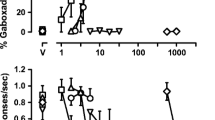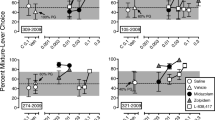Abstract
Rationale
Interactions among compounds at GABAA receptors might have important implications for the therapeutic and other effects of positive GABAA modulators (e.g. benzodiazepines).
Objectives
This study examined whether a midazolam discriminative stimulus is modified by GABAA agonists that act at sites other than benzodiazepine sites.
Methods
Rhesus monkeys discriminating midazolam (0.32 mg/kg SC) received direct-acting GABAA receptor agonists (e.g. muscimol and gaboxadol), an indirect-acting GABAA receptor agonist (progabide), ethanol, another benzodiazepine (triazolam), a barbiturate (pentobarbital), or a neuroactive steroid (pregnanolone) alone and in combination with midazolam.
Results
When administered alone, triazolam (0.1 mg/kg), pentobarbital (17.8 mg/kg) and pregnanolone (5.6 mg/kg) occasioned high levels of midazolam lever responding, ethanol (1–3 g/kg) occasioned intermediate levels of midazolam lever responding, and muscimol (0.32–1 mg/kg), gaboxadol (3.2–10 mg/kg) and progabide (10–32 mg/kg) occasioned low levels of midazolam lever responding. When combined with less-than-fully effective doses of midazolam, progabide (32 mg/kg) and ethanol (1 g/kg), but not muscimol and gaboxadol, enhanced the midazolam discriminative stimulus. Triazolam, pregnanolone and pentobarbital increased the potency of midazolam to occasion midazolam lever responding and the effects of these combinations were additive.
Conclusions
Direct-acting GABAA receptor agonists are qualitatively different from positive GABAA modulators in rhesus monkeys trained to discriminate midazolam. Although GABAA receptor agonists and modulators can enhance the actions of benzodiazepines at the GABAA receptor complex, the same drugs do not necessarily modify the discriminative stimulus effects of benzodiazepines. These results underscore the importance of the mechanism by which drugs alter Cl− flux at the GABAA receptor complex as a determinant not only of drug action but also of drug interaction and whether any particular drug enhances the behavioral effects of a benzodiazepine.






Similar content being viewed by others

References
Ator NA (2003) Selectivity in generalization to GABAergic drugs in midazolam-trained baboons. Pharmacol Biochem Behav 75:435–445
Ator NA, Griffiths RR (1986) Discriminative stimulus effects of atypical anxiolytics in baboons and rats. J Pharmacol Exp Ther 237:393–403
Bloss JL, Hammond DL (1985) Shock titration in the rhesus monkey: effects of opiate and nonopiate analgesics. J Pharmacol Exp Ther 235:423–430
Burch TP, Ticku MK (1980) Ethanol enhances [3H]diazepam binding at the benzodiazepine-GABA-receptor-ionophore complex. Eur J Pharmacol 67:325–326
De Lorey TM, Kissin I, Brown P, Brown GB (1993) Barbiturate–benzodiazepine interactions at the gamma-aminobutyric acidA receptor in rat cerebral cortical synaptoneurosomes. Anesth Analg 7:598–605
De Vry J, Slangen JL (1986) Effects of training dose on discrimination and cross-generalization of chlordiazepoxide, pentobarbital and ethanol in the rat. Psychopharmacology 88:341–345
Edgar PP, Schwartz RD (1992) Functionally relevant gamma-aminobutyric acidA receptors: equivalence between receptor affinity (Kd) and potency (EC50)? Mol Pharmacol 41:1124–1129
Friedman LK, Gibbs TT, Farb DH (1996) Gamma-aminobutyric acidA receptor regulation: heterologous uncoupling of modulatory site interactions induced by chronic steroid, barbiturate, benzodiazepine, or GABA treatment in culture. Brain Res 707:100–109
Grant KA (1999) Strategies for understanding the pharmacological effects of ethanol with drug discrimination procedures. Pharmacol Biochem Behav 64:261–267
Grech DM, Balster RL (1997) The discriminative stimulus effects of muscimol in rats. Psychopharmacology 129:339–347
Harrison YE, Jenkins JA, Rocha BA, Lytle DA, Jung ME, Oglesby MW (1998) Discriminative stimulus effects of diazepam, ketamine and their mixture: ethanol substitution patterns. Behav Pharmacol 9:31–40
Honore T, Nielsen M, Braestrup C (1984) Barbiturate shift as a tool for determination of efficacy of benzodiazepine-receptor ligands. Eur J Pharmacol 100:103–107
Johno I, Bialer M, Nickelson SA, Levy RH (1984) Disposition of progabide and valproic acid following intraperitoneal administration in rhesus monkey. Epilepsia 25:578–585
Karobath M, Sperk G (1979) Stimulation of benzodiazepine receptor binding by gamma-aminobutyric acid. Proc Natl Acad Sci 76:1004–1006
Khan ZU, Gutierrez A, De Blas AL (1996a) The alpha 1 and alpha 6 subunits can coexist in the same cerebellar GABAA receptor maintaining their individual benzodiazepine-binding specificities. J Neurochem 66:685–691
Khan ZU, Gutierrez A, Mehta AK, Miralles CP, De Blas AL (1996b) The alpha 4 subunit of the GABAA receptors from rat brain and retina. Neuropharmacology 35:1315–1322
Kissin I, Mason JO, Bradley EL (1987) Pentobarbital and thiopental anesthetic interactions with midazolam. Anesthesiology 67:26–31
Lelas S, Gerak LR, France CP (1999) Discriminative-stimulus effects of triazolam and midazolam in rhesus monkeys. Behav Pharmacol 10:39–50
Lelas S, Spealman RD, Rowlett JK (2000) Using behavior to elucidate receptor mechanisms: a review of the discriminative stimulus effects of benzodiazepines. Exp Clin Psychopharmacol 8:294–311
Lelas S, Rowlett JK, Spealman RD (2001) Isobolographic analysis of chlordiazepoxide and triazolam combinations in squirrel monkeys discriminating triazolam. Psychopharmacology 158:181–189
Lloyd KG, Arbilla S, Beaumont K, Briley M, De Montis G, Scatton B, Langer SZ, Bartholini G (1982) Gamma-aminobutyric acid (GABA) receptor stimulation. II. Specificity of progabide (SL 76002) and SL 75102 for the GABA receptor. J Pharmacol Exp Ther 220:672–677
Massey BW, Woolverton WL (1994) Discriminative stimulus effects of combinations of pentobarbital and ethanol in rhesus monkeys. Drug Alcohol Depend 35:37–43
McMahon LR, France CP (2003) Discriminative stimulus effects of positive GABAA modulators and other anxiolytics, sedatives, and anticonvulsants in untreated and diazepam-treated monkeys. J Pharmacol Exp Ther 304:109–120
McMahon LR, Gerak LR, France CP (2001) Potency of positive gamma-aminobutyric acid(A) modulators to substitute for a midazolam discriminative stimulus in untreated monkeys does not predict potency to attenuate a flumazenil discriminative stimulus in diazepam-treated monkeys. J Pharmacol Exp Ther 298:1227–1235
Mehta AK, Ticku MK (1999) An update on GABAA receptors. Brain Res Rev 29:196–217
Negus SS, Mello NK, Fivel PA (2000) Effects of GABA agonists and GABA-A receptor modulators on cocaine discrimination in rhesus monkeys. Psychopharmacology 152:398–407
Norberg L, Backstrom T, Wahlstrom G (1999) Anaesthetic effects of pregnanolone in combination with allopregnanolone, thiopental, hexobarbital and flurazepam: an EEG study in the rat. Br J Anaesth 82:731–737
Shannon HE, Herling S (1983) Discriminative stimulus effects of diazepam in rats: evidence for a maximal effect. J Pharmacol Exp Ther 227:160–166
Spealman RD (1985) Discriminative-stimulus effects of midazolam in squirrel monkeys: comparison with other drugs and antagonism by Ro 15-1788. J Pharmacol Exp Ther 235:456–462
Storustovu S, Ebert B (2003) Gaboxadol: in vitro interaction studies with benzodiazepines and ethanol suggest functional selectivity. Eur J Pharmacol 467:49–56
Tallarida RJ (2000) Drug synergism and dose–effect data analysis. Chapman and Hall/CRC, Boca Raton
Tallman JF, Thomas JW, Gallager DW (1978) GABAergic modulation of benzodiazepine binding site sensitivity. Nature 274:383–385
Tverskoy M, Ben-Shlomo I, Ezry J, Finger J, Fleyshman G (1989) Midazolam acts synergistically with methohexitone for induction of anaesthesia. Br J Anaesth 63:109–112
Van Gorder PN, Hoffman WE, Baughman V, Albrecht RF, Miletich DJ, Guzman F, Cook JM (1985) Midazolam–ethanol interactions and reversal with a benzodiazepine antagonist. Anesth Analg 64:129–135
Yang JS, Olsen RW (1987) Gamma-aminobutyric acid receptor binding in fresh mouse brain membranes at 22 degrees C: ligand-induced changes in affinity. Mol Pharmacol 32:266–277
Yang W, Drewe JA, Lan NC (1995) Cloning and characterization of the human GABAA receptor alpha 4 subunit: identification of a unique diazepam-insensitive binding site. Eur J Pharmacol 291:319–325
Acknowledgements
The authors wish to thank C. Cruz, A. Gaylor, R. Jimenez, and K. Stone for providing technical assistance. This study was supported by US Public Health Service Grant DA05018.
Author information
Authors and Affiliations
Corresponding author
Rights and permissions
About this article
Cite this article
McMahon, L.R., France, C.P. Combined discriminative stimulus effects of midazolam with other positive GABAA modulators and GABAA receptor agonists in rhesus monkeys. Psychopharmacology 178, 400–409 (2005). https://doi.org/10.1007/s00213-004-2022-4
Received:
Accepted:
Published:
Issue Date:
DOI: https://doi.org/10.1007/s00213-004-2022-4



